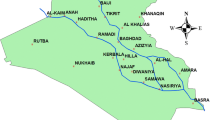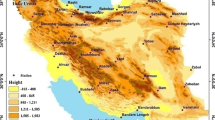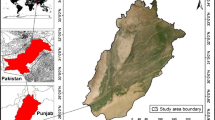Abstract
The aim of this research is to study the spatial and temporal variability of aridity in Iran, through analysis of temperature and precipitation trends during the 48-year period of 1961–2008. In this study, four different aridity criteria have been used to investigate the aridity situation. These aridity indexes included Lang’s index or rain factor, Budyko index or radiational index of dryness, UNEP aridity index, and Thornthwaite moisture index. The results of the analysis indicated that the highest and lowest mean temperatures occurred in July and January respectively in all locations. Among the study locations, Ahvaz with 37.1 °C and Kermanshah with 20.2 °C has the highest and lowest in July. For January, the highest was 12.4 °C for Ahvaz and the lowest was −4.5 °C for Hamedan and Kermanshah together. The range of monthly mean temperature of study locations indicated that the maximum and minimum difference between day and night temperatures, almost in all study locations, occurred in September and January, respectively, and the highest and lowest fluctuation of temperature was observed in Kerman and Tehran. The temperature anomalies showed that the most significant increasing temperature occurred at the beginning of twenty-first century (2000–2008) in all locations. The long-term mean of monthly rainfall showed that, in most study locations, the maximum and minimum of mean precipitation occurred in winter and summer, respectively. Rasht with 1,355 mm had the highest and Yazd with 55 mm had the lowest of total precipitation compared with other locations. According to precipitation anomalies, all locations experienced dry and wet periods, but generally dry periods occurred more often especially in the beginning of twenty-first century. According to applied different aridity indexes, all the study locations often experienced semi-arid to arid climate, severe water deficit to desert climate, arid to hyperarid climate, and semi-arid climate during the study period.






Similar content being viewed by others
References
Aydın M (1995) Water: key ingredient in Turkish farming forum for applied research and public policy. A Quarterly Journal of the University of Tennessee 10:68–70
Bannayan M, Sanjani S (2011) Weather conditions associated with irrigated crops in an arid and semi-arid environment. Agricultural Forest Meteorology 151:1589–1598
Bannayan M, Nadjafi F, Azizi M, Tabrizi L, Rastgoo M (2008) Yield and seed quality of Plantago ovata and Nigella sativa under different irrigation treatments. Journal of Industrial Crops and Products 27:11–16
Bannayan M, Sanjani S, Alizadeh A, Sadeghi Lotfabadi S, Mohamadian A (2010) Association between climate indices, aridity index, and rainfed crop yield in northeast of Iran. Field Crop Res 118:105–114
Bannayan M, Lakzian A, Gorbanzadeh N, Roshani A (2011) Variability of growing season indices in northeast of Iran. Theoretical Applied Climatology 105:485–494
Bannayan M, Eyshi Rezaie E, Hoogenboom G (2013) Determining optimum planting dates for rainfed wheat using the precipitation uncertainty model and adjusted crop evapotranspiration. Agricultural Water Management 126:56–63
Breusch T and Vahid F (2011) Global temperature trends. Australian National University, Department of Econometrics and Business Statistics, Working Paper 04/11 http://www.buseco.monash.edu.au/depts/ebs/pubs/wpapers
Brunetti M, Buffoni L, Mauger M, Nani T (2000) Precipitation intensity trends in Northern Italy. Int J Climatol 20:1017–1031
Chung YS, Yoon MB (2000) Interpretation of recent temperature and precipitation trends observed in Korea. Theor Appl Climatol 67:171–180
Dao-Yi G, Pei-Jun S, Jing-Ai W (2004) Daily precipitation changes in the semi-arid region over northern China. J Arid Environ 59:771–784
Deghan M (2001) Effects of drought on agriculture and ways to deal with it. Department of Technical and Policy. Core technical support team, Department of Agriculture
Domroes M, El-Tantawi A (2005) Recent temporal and spatial temperature changes in Egypt. Int J Climatol 25(1):51–63
Elagib A, Addin Abdu S (1997) Climate variability and aridity in Bahrain. J Arid Environ 36:405–419
Eyshi Rezaie E, Bannayan M (2012) Rainfed wheat yields under climate change in northeastern Iran. Meteorological Applications 19:346–354
Gao X, Giorgi F (2008) Increased aridity in the Mediterranean region under greenhouse gas forcing estimated from high resolution simulations with a regional climate model. Journal of Global and Planetary Change 62:195–209
Hansel S Petzold S and Matschullat J (2007) Precipitation trend analysis for Central Eastern Germany. Bioclimatology and Natural Hazards, International Scientific Conference, Poľana nad Detvou, Slovakia, September 17–20
Hess TM, Stephens W, Maryah UM (1995) Rainfall trends in the North East arid zone of Nigeria 1961–1990. Agr Forest Meteorol 74:87–97
Houghton JT, Ding Y, Giggs D, van Noguet M, del Linden P, Dai X, Maskell A, Johnson CA (2001) Climate change: the scientific basis. Cambridge University Press, Cambridge
Jensen M E Burman R D and Allen R G (1990) Evapotranspiration and irrigation water requirements. ASCE Manuals and Reports on Engineering Practice No. 70, Am. Soc. Civil Engr., New York, NY, 332 pp
Krishnakumar KN, Prasada Rao GSLHV, Gopakumar CS (2009) Rainfall trends in twentieth century over Kerala, India. Atmos Environ 43:1940–1944
Lazaro R, Rodrigo FS, Gutierrez L, Domingo F, Puigdefabregas J (2001) Analysis of a 30-year rainfall record (1967–1997) in semi-arid SE Spain for implications on vegetation. J Arid Environ 48:373–395
Liu X, Yin Z, Shao X, Qin N (2006) Temporal trends and variability of daily maximum and minimum, extreme temperature events, and growing season length over the eastern and central Tibetan Plateau during 1961–2003. J Geophys Res 111, D19109
Liu Q, Yang Z, Cui B (2008) Spatial and temporal variability of annual precipitation during 1961–2006 in Yellow River Basin, China. Journal of Hydrology 361:330–338
Lungu M, Panaitescu L, Nita S (2011) Aridity, climatic risk phenomenon in Dobrudja. Journal of Present environment and sustainable development 5(1):179–190
Malamud BD, Turcotte DL, Grimmond CSB (2011) Temperature trends at the Mauna Loa observatory, Hawaii. Journal of Climate of the Past 7:975–983
Manton MJ, Della-Marta PM, Haylock MR, Hennessy KJ, Nicholls N, Chambers LE, Collins DA, Daw G, Finet A, Gunawan D, Inape K, Isobe H, Kestin TS, Lefale P, Leyu CH, Lwin T, Maitrepierre L, Ouprasitwong N, Page CM, Pahalad J, Plummer N, Salinger MJ, Suppiah R, Tran VL, Trewin B, Tibig I, Yee D (2001) Trends in extreme daily rainfall and temperature in Southeast Asia and the South Pacific: 1961–1998. Int J Climatol 21:269–284
Modarres R, Silva VPR (2007) Rainfall trends in arid and semi-arid regions of Iran. J Arid Environ 70:344–355
Nastos PT, Politi N, Kapsomenakis J (2011) Spatial and temporal variability of the Aridity Index in Greece. Journal of Atmospheric research 119:140–152
Nazemosadat MJ, Cordery I (2000) On the relationships between ENSO and autumn rainfall in Iran. Int J Climatol 20:47–61
Oliver J E (2005) The encyclopedia of climatology. Springer, New York: Van Nostrand Reinhold 854 pp
Partal T, Kahya E (2006) Trend analysis in Turkish precipitation data. Hydrological Processes 20:2011–2026
Philandras CM, Nastos PT, Kapsomenakis J, Douvis KC, Tselioudis G, Zerefos CS (2011) Long term precipitation trends and variability within the Mediterranean region. Journal of Natural Hazards and Earth System Science 11:3235–3250
Rahimzadeh F, Asgari A, Fattahi E (2009) Variability of extreme temperature and precipitation in Iran during recent decades. Int J Climatol 29:329–343
Saghfiyan B (2009) Evaluation and prediction of drought in the region. Staff Research Projects symbiotic harmony with the land. Ministry of Agriculture, Center of Research Agriculture and Natural resources of Khorasan Razavi. p 120.
Sanjani S, Bannayan M, Kamyabnejad M (2011) Detection of recent climate change using daily temperature extremes in Khorasan Province, Iran. Climatic Research 49:247–254
Sayari N, Bannayan M, Alizadeh A, Farid A (2013) Using drought indices to assess climate change impacts on drought conditions in the northeast of Iran (case study: Kashafrood basin). Meteorological Applications 20:115–127
Silva VPR (2004) On climate variability in Northeast of Brazil. J Arid Environ 58:575–596
Subyani A, Al-Modayan A, Al-Ahmadi F (2010) Topographic, seasonal and aridity influences on rainfall variability in western Saudi Arabia. Journal of Environmental Hydrology 18:1–11
Tabari H, Hosseinzadeh Talaee P (2011a) Temporal variability of precipitation over Iran: 1966–2005. Journal of Hydrology 396:313–320
Tabari H, Hosseinzadeh Talaee P (2011b) Analysis of trends in temperature data in arid and semi-arid regions of Iran. Global Planet Change 79:1–10
Turkes M, Sumer UM (2004) Spatial and temporal patterns of trends and variability in diurnal temperature ranges of Turkey. Theor Appl Climatol 77:195–227
United Nations Environment Program (UNEP) 1992 World atlas of desertification
Author information
Authors and Affiliations
Corresponding author
Rights and permissions
About this article
Cite this article
Ashraf, B., Yazdani, R., Mousavi-Baygi, M. et al. Investigation of temporal and spatial climate variability and aridity of Iran. Theor Appl Climatol 118, 35–46 (2014). https://doi.org/10.1007/s00704-013-1040-8
Received:
Accepted:
Published:
Issue Date:
DOI: https://doi.org/10.1007/s00704-013-1040-8




